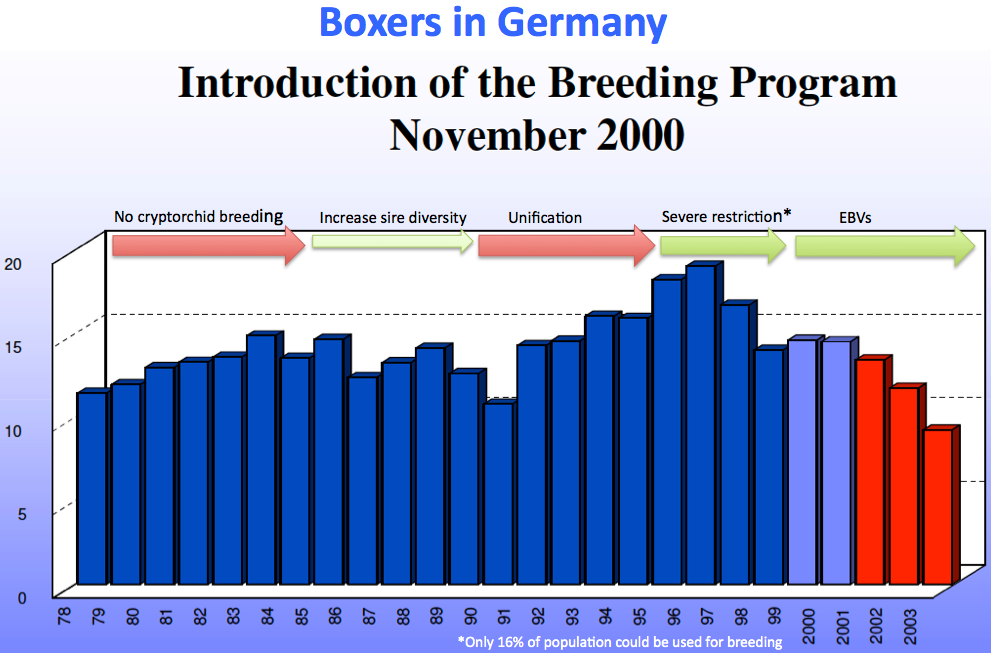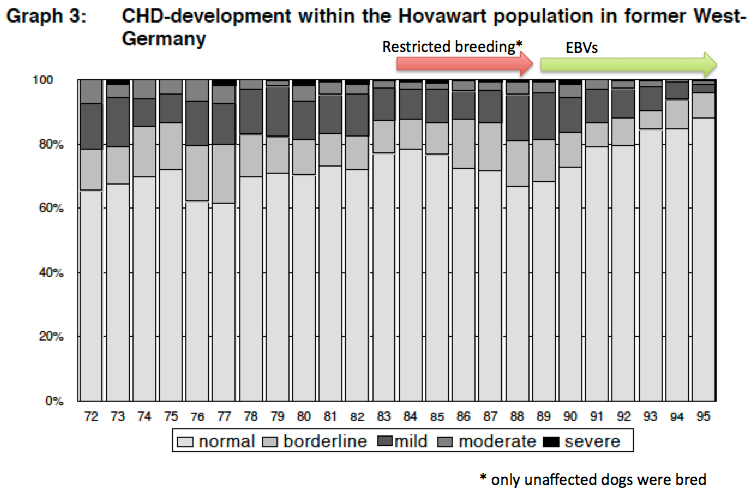The first step in planning a breeding is to evaluate the traits you want (and don't want) in potential sires. For the ones that are heritable - i.e., at least partially determined by genetics, what you would really like to know is whether the dog has the specific genes to produce the traits you want in the offspring. We have DNA tests for a few useful things like coat color and some diseases, but for the most part the genes that are actually in the dog are an unknown.
If you're an experienced breeder, you know that you can look at a dog's relatives - parents, aunts and uncles, litter mates, and especially offspring to get an idea of what a dog is likely to throw. What you are trying to do is predict the "breeding value" of a dog; that is, how likely it is to produce offspring with a particular trait. Sometimes the picture is clear, but sometimes it's complicated and you are left to trust your gut with fingers crossed behind your back. And the very best you can do is make a subjective, no-doubt biased, and very qualitative guess.
There are better ways to do this. If you know a trait is inherited, and you also know that a dog gets half of its genes from the sire and half from the dam, then you can make some predictions about how likely a dog is to be carrying the genes of a particular ancestor. You do this sort of thing when you use coefficient of inbreeding to estimate the probability of producing puppies that will be homozygous for a recessive allele inherited from both sides of the pedigree. We can do the same thing to come up with a quantitative (i.e., numerical) estimate of a dog's breeding value for a particular trait, called the "estimated breeding value" (EBV).
You will remember that phenotype (P) depends upon both genetics (G) and environment (E):
EBVs have been used with great success for many decades by breeders of other domestic animals. "But", I hear you say, "dogs aren't livestock". Can EBVs be used successfully in dogs?
Yes. Here are a couple of examples. You will see that in both, the efforts of breeders to control a genetic problem by selecting against an undesirable phenotype had little success before the adoption of EBVs.
Cryptorchidism in Boxers
Cryptorchidism (the failure of a testicle to descend) is a problem in many breeds, and historically, Boxers have had a high incidence of cryptorchidism. If neither testicle descends, the dog will be sterile because the heat of the body interferes with sperm production. But a dog with one testicle is fertile (although prone to testicular tumors).
Most living Boxers can trace their pedigrees to four German stud dogs - Sigurd von Dom and his three grandsons, Utz von Dom, Dorian von Marienhof, and Lustig von Dom. All four of these dogs produced cryptorchid offspring. The first efforts to reduce the frequency of cryptorchidism in Boxers began in 1942, with a total ban on breeding cryptorchids (see the graph below). Nevertheless, the incidence of cryptorchidism increased in East German dogs over the next 40 years from about 6% in 1941 to 10% in 1981. In West German dogs, it increased from 7% in 1959 to 14% in 1985. In 1985, concerns about genetic diversity in the breed prompted the kennel club to encourage breeders to use lesser known males and breed away from popular sires, but this still did not improve the incidence of cryptorchidism.
The unification of Germany in 1990 increased access to a broader gene pool, but cryptorchidism continued to increase unabated. In 1996, once again strict regulations on breeding were imposed. Bitches were excluded from breeding if they produced cryptorchid offspring in 2 litters, and sires were culled that produced more than 15% cryptorchids in at least 20 offspring. This policy reduced the frequency of cryptorchids, but it also removed 84% of the reproductive dogs from the breeding pool (not a good thing), and in any case improvement tailed off after a few years.
Hip dysplasia in Hovawarts
EBVs have been used to successfully reduce the frequency of canine hip dysplasia (CHD) in several breeds. The data in the graph below are from a breeding program against CHD in the Hovawart. After efforts to reduce hip dysplasia using selection against phenotype failed to produce consistent improvement, severe breeding restrictions were instituted in 1984 that banned all affected dogs from breeding. This actually made things worse, reducing the number of unaffected dogs and increasing the number of dogs classed as borderline.
In 1989, selection based on EBVs was instituted, and this produced immediate, significant improvement in hip scores. In only 5 years more than 80% of all dogs had normal hips, and severely afflicted animals were nearly eliminated.
Using EBVs for selection can produce one problem that is common to phenotypic selection as well. If everybody rushes to breed to the dog with the best EBV score, this will create a bottleneck and increase inbreeding if care is not taken to balance the reproduction of animals across the breadth of the gene pool. This should be a basic part of sound genetic management of a breeding population of animals anyway, regardless of the scheme breeders are using to make breeding decisions.
EBVs will be new to many dog breeders, but in fact they have been used for decades to guide breeding decisions of service dogs by Guiding Eyes for the Blind, Seeing Eye, and other organizations. Using EBVs, a well-run organization can manage genetic disorders, limit inbreeding even in a closed gene pool, and produce dogs with the traits that are important in a service dog. This improves the efficiency of the breeding program because more of the dogs produced are suitable for service.
Dog breeders can use EBVs to improve selection for the traits they want and reduce the ones they don't (Lewis et al 2013). EBVs can be used on any trait that can be evaluated by the breeder - temperament, size, herding ability, coat quality, heart disease, "showiness", hip dysplasia - anything you can judge to be better or worse, desirable or not desirable. EBVs are becoming available in more and more countries through the kennel clubs, and they are the most powerful tool now available for improving the health and well being of dogs.
Beuing R. Strategies in modern dog breeding. (pdf)
Lewis TW, SC Blott, & JA Wooliams. 2013. Comparative analysis of genetic trends and prospects for selection against hip and elbow dysplasia in 15 UK dog breeds. BMC Genetics 14:16 (pdf)
You can learn more about the genetics of dogs in ICB's online courses.
Visit our Facebook Groups
ICB Institute of Canine Biology
...the latest canine news and research
ICB Breeding for the Future
...the science of animal breeding



